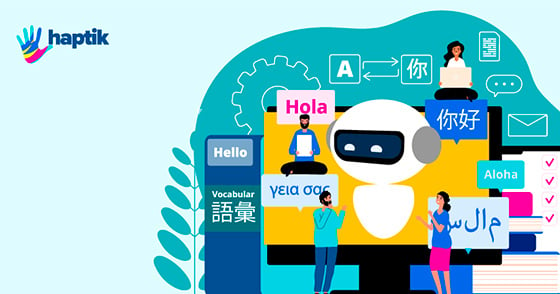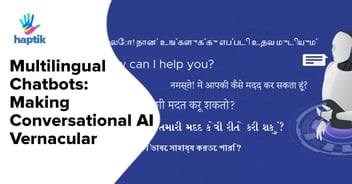It is said that the language keeps changing every 100 miles you travel, irrespective of your demographics or direction. But, when it comes to expanding your business globally, you need to be capable of communicating in multiple languages no matter what your geographical location is. Businesses are now able to see the benefits of being multilingual while communicating with global customers as they expand their territories for revenue growth.
Since multilingual capabilities are not possessed by every human agent communicating with customers, business strategists are now targeting to deploy AI-powered intelligent chatbots into their support system. These multilingual chatbots are capable of supporting vernacular languages that help businesses to expand their global customer base to the regions where English is not a primary language.
According to a survey by Oracle , when asked which emerging technologies they are already using, 80% of respondents said they have already used or are planning to use AI-powered intelligent chatbots by 2021.
The survey showed that business leaders are preferring to dote on AI automation technologies, which includes chatbots, for sales, marketing, and customer service. 42% of the participants believe that AI-powered automation technologies in these areas will augment the CX curve for their businesses. Also, 48% said that they are already using chatbots for their business functions, with 40% planning to implement some form of cognitive AI-powered technology by 2021.
Although complete automation of the customer service workforce is not feasible, automating customer management and sales positions using AI chatbots in the US would result in considerable savings. According to Public Tableau, 29% of customer service positions in the US could be automated through chatbots and other cognitive AI-powered IVAs that estimate up to $23 billion in savings from annual salaries.
While AI-chatbots will become omnipresent in the next few years, multilingual capabilities will further help businesses to drive growth.
What is a Multilingual Chatbot?
A Multilingual Chatbot is an AI-powered intelligent virtual assistant (IVA) that allows businesses to communicate with users speaking various local and regional languages other than English. Conventional chatbot technology has a limitation of conducting a conversation only in one specific language. Multilingual Chatbots are interactive software platforms that reside in apps, live chat, email, or SMS, and can communicate with customers in the languages they are most comfortable with.
For example, if your business is in the US and you are planning to open a market in Asia, your website might have a chatbot that communicates in English, but not everyone in Asia speaks English. While it is helpful for US customers, the chatbot’s inability to communicate in other languages will hinder companies' growth in Asia. All this results in the multiplication of efforts, time, and costs.
Multilingual chatbots are capable of communicating in multiple languages – not just translating the dialects. Gone are the days where multilingual meant “Translate and Understand”.
Building multilingual chatbots requires more than just processing text or dialogue in English through a language translator. To effectively communicate in multiple languages, a chatbot must be aware of the end-users’ culture and able to understand regional nuances. This can be done using AI NLU models.
Natural language understanding (NLU) is a branch of artificial intelligence that uses these intelligent chatbots to understand input made in the form of text or speech, and respond in the same manner and context.
In NLU, machine learning models improve over time as they learn to recognize syntax, context, language patterns, unique definitions, sentiment, and intent. Business applications often rely on NLU to understand what people are saying in both spoken and written language. It helps them provide a personalized response to their customers that improves the end-user experience.
With consistent development in Artificial Intelligence technology and Natural Language Understanding (NLU) models, building a multilingual chatbot is no longer a big deal. However, staying on top of the emerging AI technologies is the real need of the hour for business leaders who see it as a topmost priority.
Why is it needed?
While translator services are rapidly improving their capabilities to detect and translate, Natural Language Understanding (NLU) services are much ahead of the curve in language processing. The growing demand for language and locale understanding capabilities in chatbots is driving the continuous evolution of these services.
Business studies suggest that most customers, in spite of being multilingual, prefer to interact with your brand in their native language. In order to localize a brand, one must ensure that customers can interact in a language they are most comfortable with. Multilingual chatbots are thereby the most efficient and cost-effective answer to meet this demand. Here are a few reasons why a multilingual chatbot becomes a priority for global businesses:
Benefits of a Multilingual Chatbot
Multilingual chatbots help businesses stay ahead of the curve in terms of customer service experience. Contact centres leveraging multilingual chatbots help and troubleshoot problems for customers in a language that they are most comfortable with. A multilingual chatbot can seamlessly switch between languages, hence enhancing and personalizing the customer service experience.
Here are the key benefits of using multilingual chatbots:
-
Save Costs - Considering the difficulty in recruiting resources of varied language proficiency, businesses end up saving a lot of money by deploying multilingual chatbots. Companies still spend a huge amount of money on hiring multilingual staff to connect with the local customer base, which is not an efficient approach. Hiring and training resources incur more expenses to the business. Therefore, implementing a cost-efficient solution becomes the primary priority for decision-makers. Multilingual Chatbots make it possible for them.
-
Improve CSAT: Offering multilingual support doesn’t just drive CSAT scores, it can even impact churn. According to a recent research, 29% of businesses say they’ve lost customers because they don’t offer multilingual support. Additionally, 70% of end-users say they feel more loyal to businesses that provide support in their native language. A multilingual AI chatbot interacts with your customers of different local languages without any error. Multilingual chatbots are trained to answer repetitive queries in any language without skipping any important information. It’s going to stay 24/7 available and provide customers with the best possible experience.
-
Convert Leads Globally: With 57% of global companies already adopting Conversational AI technology, the percentage is way lower when it comes to adopting multilingual AI chatbots. So, there is a strong possibility that your competitors have still not adopted a multilingual chatbot. If so, deploying an AI-powered multilingual AI chatbot can easily be your deal-breaker. If you’re planning to go global and you have already deployed a multilingual AI chatbot that can communicate in 40+ languages, half of the lead-generation battle is already won.
-
Develop Local Customer Base: An AI-powered intelligent chatbot that converses in the local language can take customer communication to a next level. According to an article by Inside Intercom, 35% of end users would even be willing to switch products to one that offers support in their native language. As a result, most of the businesses are adopting localization strategies to expand their customer base and drive engagements in the local language. Localization means customizing your product/service offerings according to the demands and expectations of the local customers. For businesses willing to invest and adopt a comprehensive multilingual AI chatbot localization strategy, the payoff turns into a success story.
Read on: Linguist Pro - Never let language be a barrier
NLP: The Technology Behind Multilingual Chatbots
It is evident that for Conversational AI technology to be truly successful, it should be able to interact with users in the language they are most comfortable with. Most multilingual chatbots are either programmed with a sophisticated NLP engine that helps them identify language, or more commonly, a bot designer platform that redesigns and trains the chatbot to interact in that specific language. Natural Language Processing allows a machine to understand what we say in our natural language. That is, the way we naturally speak, with slang, abbreviations, mispronunciations and so on.
Key Capabilities that NLP provides:
-
NLP allows chatbots to understand voice input as well as text.
-
With NLP technology, the chatbot doesn’t need the exact correct syntax to understand customer’s expectations.
-
On the basis of its programming mechanism, it can auto-detect languages, context, sentiment, and intent.
-
Chatbots can either process their response through its NLP engine, or by analyzing customer’s browser preferences.
Final Thoughts
Chatbots have gained attention worldwide, and with the help of evolving AI and NLP technology, they are expected to become even more empowered in the coming days. With a number of businesses trying to use AI-powered chatbots in different innovative ways, building multilingual chatbots helps businesses connect with a wider and more diverse audience, in fact globally.
For an AI chatbot to be well-received and widely used, it is important that it can convincingly converse in a language that is most convenient to the customer. And since the business landscape has become largely global, multilingual communication has become a topmost priority. This is because an AI-powered multilingual chatbot solution can give wings to the customer experience transformation initiative and improve overall ROI for your business.
I hope this article helped explain how AI-powered multilingual chatbots stand out in the crowd. Designed by Haptik, these chatbots have been assisting brands to have more efficient and meaningful conversations in the language customers prefer. And it would be fair to say that the next generation of Conversational AI is at your doorstep and it’s time to embrace these impeccable AI-powered chatbot solutions.
Reach out to enterprise@haptik.ai to learn how Haptik can help your business!
Are you interested in developing a Conversational AI solution for your business?




-png.png?width=352&name=Ikhophi%20ye-Bots%20Going%20Live%20-%20LinkedIn%20(1)-png.png)
